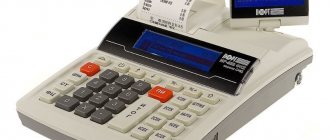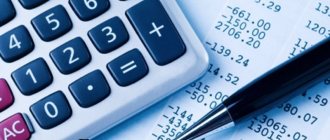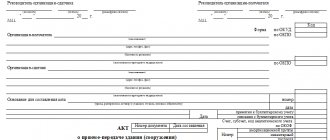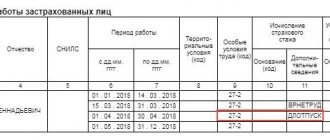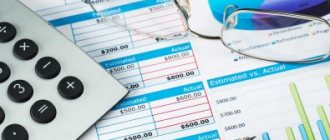Simplified reporting can be submitted by small businesses, non-profit organizations and participants in the Skolkovo project that are not subject to the restrictions established by clause 5 of Art. 6 of the Federal Law of December 6, 2011 No. 402-FZ. Simplified reporting forms used for the 2021 report are contained in Appendix No. 5 of Order No. 66n of the Ministry of Finance of the Russian Federation dated July 2, 2010 (as amended on April 19, 2019). Line codes in the simplified financial statements of the company are indicated independently. We will tell you what is included in each indicator and how to choose the necessary encoding for it.
Where are the line codes?
Indicators about the company's activities are grouped into consolidated items reflected in the reporting. All information is provided in a generalized form. According to clause 5 of Order No. 66n, in simplified financial statements, the organization enters line codes independently. The numerical value chosen by the company must correspond to the prevailing indicator in the specific weight in the completed article of each form. Line codes in simplified financial statements for 2021 are selected from Appendix No. 4 to Order No. 66n.
Our offers
Many people believe that business can be run solely on intuition. And it is true. But only for the time being. Until your intuition fails you. In order to “put straws in”, it is better to provide yourself with a tool that always works well. This tool for a businessman is financial reporting. Let's talk about her.
Let's immediately answer the main question: what is “Financial reporting”?
The term “Financial reporting” is commonly perceived by many as a synonym for the term “Accounting reporting”. This was the case before, when enterprises kept exclusively regulated records of their economic activities. With the transition to market conditions, the role of regulated accounting for an enterprise began to decline. Such accounting does not provide sufficient information for managers and investors. Over time, parallel types of accounting appeared: management accounting in different variations and accounting according to IFRS. They can use a more flexible and accurate approach to reflecting the results of business activities. But the main forms of financial reporting: Balance Sheet (BL), Income Statement (or Profit and Loss Statement (PL)), and Cash Flow Statement (CF), have not lost their relevance and fit perfectly into these new types of accounting.
The main forms of reporting on which the fundamental analysis of the financial activities of an enterprise is based are the same for all types of accounting.
Do you know that?
But their content may have significant differences. This is due to the specifics and rules defined by the enterprise to reflect business transactions in an unregulated form of accounting (i.e. not regulated by the state). I talked about regulation methods in my webinar. There she also spoke about three main questions, answering which the manager or financial director determines the criteria for reflecting a business transaction in accounting and, accordingly, in reporting:
- What amount? the transaction amount reflected in accounting is not always equal to the amount reflected in management accounting;
- Where? in which sections and which reporting forms should the business transaction be reflected;
- What analytics? must be assigned to a business transaction.
Now, when using the term “Financial reporting”, we will understand that these are reporting forms generated in accordance with the rules and requirements of the type of accounting in question. If your company, in addition to accounting, also maintains management accounting, then you will have 2 sets of basic reporting forms:
| Types of accounting | Reporting forms | ||
| Accounting | Balance | Income statement | Cash flow statement |
| Management Accounting | Balance | Income statement | Cash flow statement |
Please note!
Some managers believe that to make management decisions it is enough to have only a cash flow statement on hand. I hasten to disappoint you. It's a delusion. It is fraught with financial troubles. The presence of money in a company’s accounts does not always indicate its financial well-being. Let's move on to a more detailed dive into this interesting topic.
What do reporting forms reflect, how are they formed and how are they interconnected?
I will not follow book descriptions, but will offer you my vision. I suggest you constantly return to the diagram below during my explanation and then everything will become clear.
Relationship between financial reporting forms
Some may find this scheme very complicated and uninteresting. But after reading the article to the end, you will understand that everything is very simple. I propose to understand once and for all: what these three forms of reporting are, how they are interconnected and how you can easily navigate them, getting the benefit you need.
Let's begin.
- Balance sheet: reflects the general position of the organization at the reporting date.
The balance sheet is formed on two reporting dates: the beginning of the reporting period (RP) and the end of the reporting period (CP). The dynamics of changes in indicators between two reporting dates of the Balance Sheet reflect the results of monetary (CF) and non-monetary (PL) transactions. Or, in other words, two results of activity in the period under review:- According to CF - how much money is generated, and what is the balance.
- According to PL - what is the result of the activity (profit/loss).
The balance consists of two parts:
- Assets are the company's future cash inflow, that is, what can be converted into cash (fixed assets, accounts receivable, and cash itself).
Hence the conclusion: There are monetary and non-monetary assets.
- Liabilities are the future outflow of money, i.e. how much will need to be paid (accounts payable, deferred expenses, various reserves).
This refers to cash, non-cash funds and cash equivalents at the beginning and end of the reporting period. In addition, it displays in detail the receipt and expenditure of funds for various types of activities. That is, it summarizes the significant reasons for changes in funds during the reporting period.
Balance of Cash at the beginning and end of the reporting period = Cash Assets in the Balance Sheet structure.
PL contains information about the amount of income and expenses that were made to generate this amount of income.
Please note!
The result of financial activities (profit/loss) affects the change in Capital in the Balance Sheet in the form of retained earnings.
Conclusion: CF enters the balance sheet as the cash balance in the asset. PL is reflected in the company's capital. The balance sheet is considered as a snapshot of the company's condition at two reporting dates. And only by analyzing all three forms of reporting together, you can understand the financial condition of the business and what difficulties it is experiencing.
Please note!
In practice, PL and CF are always compared because they provide details of the transactions performed by the enterprise between two reporting dates.
The main differences between PL and CF are:
- In PL, a transaction is always reflected at the moment it is carried out, and not when the payment is made.
Example: On the date of receipt of an advance for an upcoming service, a cash receipt transaction in CF is created. But, since the service has not yet been provided, revenue is not reflected in PL. Thus, we obtain a discrepancy in the reflection of the income transaction.
- The PL reflects adjustments to income and expenses, which are recognized as an Asset and a Liability, if there are grounds for this.
Example: You have formed an asset: a deposit for 6 months, with the payment of income in the form of interest on the maturity date. Since this asset already formally generates income in the form of interest, you must reflect it in PL as income, despite the fact that the transaction is not yet in CF. Same with loan costs. Since this obligation, during its existence, “generates” expenses in the form of interest on the loan for each month, we must reflect them in PL in the period in which they are accrued. At the same time, in CF we will reflect the debiting of funds only on the date of actual payment.
It remains to consider the question of what automation tools can be used to generate financial statements.
Automation Tools
There are many offers on the information solutions market that position themselves as automated systems for generating financial reporting, but in fact there are only a few serious “players”. You need to analyze several of these systems and choose the most suitable one that meets your requirements.
First of all, you need to make a decision: what financial statements are required to manage the business. It is important to know that many IT products will allow you to generate only one reporting form - CF. By analyzing such a report, you can determine only how much money the assets brought in over a certain period of time. But! You will not be able to determine the profitability of your business for the period, since you will not see the PL report. The volume of your current capital, how much your counterparties owe you and your debt will be unknown.
Unlike narrowly focused solutions, the Galochka service offers full-fledged management accounting, which contains all three necessary forms of reporting, and is fully integrated with the data of your accounting system: 1C, Excel, and other analogues. The checkbox has built-in functionality that allows you to create any level of analytics for income and expenses, and also generates reports of any form and complexity in the required detail.
You can learn more about the capabilities of our service on the website
conclusions
Reporting
- PL - shows the use of resources for the period;
- CF - shows how much cash these resources generated during the period;
- ВL - shows the current capitalization of the enterprise, and, if necessary, the capitalization of its individual divisions.
Automation of reporting
Choose management reporting automation systems that allow you to flexibly modify the logic for constructing this reporting and can integrate “on the fly” with your accounting systems.
In the following articles we will talk about Automation of Accounting and Building Management Accounting from scratch.
stroki_ofr.jpg
Indicators with a negative value are indicated in parentheses.
Report on the intended use of funds (OKUD 0710003)
The form is filled out by NPOs and firms that received targeted funds. Other companies do not need to submit these reports. The lines contained in this form do not need a detailed description, so we will provide a brief breakdown of the indicators in Table 3.
BALANCE
| Current assets | Liabilities | ||
| Money in the cash register | 10 000 ₽ | Accounts payable | 90 000 ₽ |
| Coffee beans | 30 000 ₽ | ||
| Paper glasses | 10 000 ₽ | ||
| Fixed assets | Capital and reserves | ||
| Coffee machine | 40 000 ₽ | Equity | 10 000 ₽ |
| Coffee grinder | 20 000 ₽ | Retained earnings | 10 000 ₽ |
| Assets | 110 000 ₽ | Liabilities | 110 000 ₽ |
stroki_otchet_o_celevom_ispolzovanii.jpg
Material information affecting the reliability of reporting is disclosed in separate lines or in additional appendices. The company makes its own decision about what data to provide in more detail. The company sets the code in its reporting according to the indicator that has the maximum value in the line of the form containing the combined data. An organization can refuse to use simplified forms by choosing full accounting reporting and enshrining this in its accounting policies.
Third report. Balance
To make management decisions, a business owner needs information. It is useful for him to see the business as a whole - to evaluate and understand all the details. This is what the Balance Sheet or Balance Sheet is for.
Andrey buys selfie sticks in China and sells them through retail outlets in large shopping centers. The balance helps him understand how much of the money is now “in goods” - he will not be able to quickly pull it out and direct it to the spinners that are gaining popularity. To play on demand, Andrey will have to take a loan from a partner or go to the bank for a loan.
A balance sheet is a summary: a snapshot of a company at a specific point in time.
The Balance Sheet summarizes all the company's assets - what it owns; and liabilities - those funds on which he lives. That is, on the one hand, this is equipment, raw materials and goods in stock, and on the other hand, loans and borrowings, investments in authorized capital and retained earnings. The assets and liabilities of the balance sheet are always equal to each other - nothing in the world arises from emptiness.
Money has several aggregate states in its assets. Equipment is difficult to sell, but money in the account is easy to use. The easier it is to release investments, the higher the liquidity of the asset. On the other hand, each liability has its own degree of urgency - something needs to be returned quickly, something may be with the company all the time. The balance sheet helps you see the current state of the money and correlate liquidity and urgency.
Other reporting
- Invoice. This document is issued to the buyer by the seller in order to record the fact of the transaction, as well as to determine VAT. You can select standard and advance. The peculiarity of a standard invoice is that it is sent either along with the goods or after shipment or provision of services. The advance payment is sent with the first prepayment to account for future deliveries.
- Proforma invoice. This is a financial document that is needed to determine the cost of goods when transported across the border. Features include shipping before the transaction is completed, as well as possible differences in price, quantity and total cost compared to the invoice. Does not constitute a basis for payment.
- Invoice. This is the financial document that is most often used in international trading practices. This document is mandatory in international trade. The invoice indicates all the quantitative and qualitative characteristics of the goods, is transferred simultaneously with the goods and indicates the full final cost of the goods and the owner.
- Certificate of origin of the goods. This document is a secure form that certifies the customs control of the Russian Federation or another country. This certificate is needed when importing or exporting goods, to determine the competitiveness of this product relative to domestic producers, as well as to provide possible import benefits.
The right to sign financial documents
Financial documents are important components of the successful operation of any enterprise that is engaged in foreign economic activity. It is necessary to correctly draw up and certify these papers so that they do not lose their legal force.
The first and second signing rights belong to the director of the enterprise and the chief accountant, respectively. The remaining rights can be transferred to authorized persons. To obtain the right to perform this procedure, they must have a power of attorney. You can verify it in two ways:
- Inside the enterprise, by drawing up a special order. This method is used most often. It does not require large financial and time expenditures, and is also easy to implement.
- Through a notary. This method is much less common.
The right to sign is often held by the company's accountant. But if necessary, it can be transferred to any other authorized employee.
